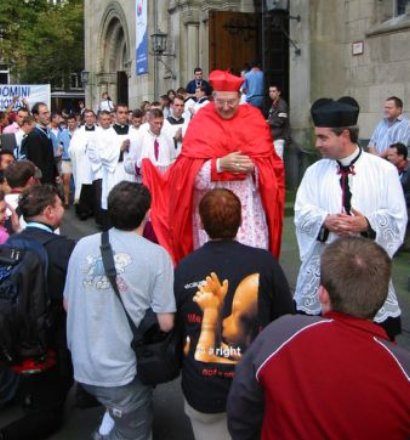Apart from annoyances such as the poor location of the Altar Cross at St John Lateran, there are other issues with versus populum facing Altars constructed in the post Vat II years. In many existing churches of the time, the new table Altar was placed at the bottom of the Altar steps, in front of the existing High Altar. In some places, the High Altar was completely removed and the priests chair put in its place, and the tabernacle located elsewhere. In other places, the old high Altar was adapted into a modern table Altar.
This of course makes:
- the church look lopsided, as it was designed for ad-orientem celebration
- the Altar look like a minor furnishing in the sanctuary rather than the total centre of worship (ie just a table).
One of the less disturbing examples is shown here.
Altars facing versus populum in the the Roman basilicas were designed with a different purpose to "making the contact with the people easier".
Here is a pic that I took of Santa Maria in Trastavere. This church was first constructed by Pope Julius I (reigned 337-352) and enlarged by Pope Gregory IV (828-844). The current building that I visited is a rebuild by Pope Innocent II (1130-43). As you can see building in the basilica form with the bishop's throne at the end of the apse, and a versus populum Altar under a ciborium was the orthodox manner of church arrangment well into the high Middle Ages.
Lets take a walk into the sanctuary and look at the proper arrangement of the Altar.
 The sanctuary is separated from the nave by a substantial arrangement of stairs and walls, which reminded me of the arrangement of the Old St Peters. the Altar itself is surmounted on two steps with a timber third step (or pradella) being that on which the priest celebrates upon. The whole Altar is framed by the ciborium.
The sanctuary is separated from the nave by a substantial arrangement of stairs and walls, which reminded me of the arrangement of the Old St Peters. the Altar itself is surmounted on two steps with a timber third step (or pradella) being that on which the priest celebrates upon. The whole Altar is framed by the ciborium.
When versus populum Altars came back into fashion in the last half of the 20th century, the architectural setting to make it look truly the Altar of sacrifice was totally forgotten. For instance the first thing that I notice upon return to Australia is that the Altars are too low and look too much like tables. I am sure that this is deliberate intent, in view of the mistaken theologies which run rampant in the local church.
 I am not opposed to versus populum Altars per-se, but they need to be constructed with dignity worthy of the Holy Sacrifice. Most churches in Rome seem to see the Altar cross as a distraction , but here is the view of one (St Nicholas in Carcere), which has done it correctly with four candles and the cross in the middle (click on pic for a better look). Also here is a close up of the Altar and ciborium which shows the step arrangment.
I am not opposed to versus populum Altars per-se, but they need to be constructed with dignity worthy of the Holy Sacrifice. Most churches in Rome seem to see the Altar cross as a distraction , but here is the view of one (St Nicholas in Carcere), which has done it correctly with four candles and the cross in the middle (click on pic for a better look). Also here is a close up of the Altar and ciborium which shows the step arrangment. Of course these churches would have had the celebration of Mass in the evolving classical form until 40 years ago. There was no problem with celebrating the Tridentine Mass versus populum so I cannot see what the problem is with the Ordniary form (Novus Ordo) Mass being celebrated ad orientem.
Of course these churches would have had the celebration of Mass in the evolving classical form until 40 years ago. There was no problem with celebrating the Tridentine Mass versus populum so I cannot see what the problem is with the Ordniary form (Novus Ordo) Mass being celebrated ad orientem.










 This is the High Altar of the Basilica of St John Lateran. So we hope that the new Marini (recently appointed Papal MC) will address this. Just a job that would take a few seconds cost=0, level of effort = 0, benefits to the people - boundless.
This is the High Altar of the Basilica of St John Lateran. So we hope that the new Marini (recently appointed Papal MC) will address this. Just a job that would take a few seconds cost=0, level of effort = 0, benefits to the people - boundless.










